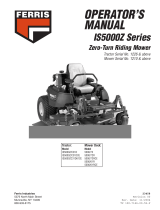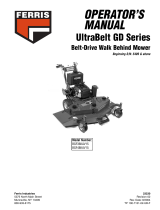NOTE: Diesel fuel, if permitted to stand unused for extend-
ed periods (30 days or more), may develop gummy
deposits which can adversely affect the fuel pump and
injector tubes and cause engine malfunction.To avoid this
condition, add a diesel fuel stabilizer to the fuel tank and
run the engine a few minutes, or drain all fuel from the unit
before placing it in storage.
STARTING AFTER
LONG TERM STORAGE
Before starting the unit after it has been stored for a long
period of time, perform the following steps.
1. Remove any blocks from under the unit.
2. Install the battery if it was removed.
3. Unplug the exhaust outlet and air cleaner.
4. Fill the fuel tank with fresh fuel. See engine manual for
recommendations.
5. See engine owner’s manual and follow all instructions
for preparing engine after storage.
6. Check crankcase oil level and add proper oil if neces-
sary. If any condensation has developed during stor-
age, drain crankcase oil and refill.
7. Inflate tires to proper pressure. Check fluid levels.
8. Start the engine and let it run slowly. DO NOT run at
high speed immediately after starting. Be sure to run
engine only outdoors or in well ventilated area.
DIESEL FUEL RECOMMENDATIONS
Fuel companies provide fuel tailored to meet the existing
weather conditions. These fuels change at the start of the
predominant season according to regional weather trends.
Winter fuels are tailored to give ease of starting for cold
weather. Summer fuel may be somewhat heavier than win-
ter fuel resulting in slightly better fuel economy and power.
Spring and fall fuel is an average blend between winter and
summer blend.
For these reasons an effort should be made to purchase
fuels in such quantities that they are not carried over into
the next season. Using the wrong blend of fuel can cause
problems with the engine.
Refer to the engine manufacturer’s manual for specific fuel
recommendations.
STORAGE (Diesel model)
Temporary Storage (30 Days Or Less)
Remember, the fuel tank will still contain some fuel, so
never store the unit indoors or in any other area where fuel
vapor could travel to any ignition source. Fuel vapor is also
toxic if inhaled, so never store the unit in any structure used
for human or animal habitation.
Here is a checklist of things to do when storing your unit
temporarily or in between uses:
• Keep the unit in an area away from where children may
come into contact with it. If there’s any chance of unau-
thorized use remove the ignition key.
• If the unit can’t be stored on a reasonable level surface,
chock the wheels.
• Clean all grass and dirt from the mower.
• If temperature is expected to drop below 35 degrees,
refer to Long Term Storage, Item 2.
Long Term Storage (Longer Than 30 Days)
Before you store your unit for the off-season, read the
Maintenance and Storage instructions in the Safety Rules
section, then perform the following steps:
1. Drain crankcase oil while engine is hot and refill with a
grade of oil that will be required when unit is used
again.
2. Use an Antifreeze tester to check the cooling system’s
level of protection. Read the instructions on the
Antifreeze container for the appropriate ratio of water to
Antifreeze for your geographical area.
3. Prepare the mower deck for storage as follows:
a. Remove mower deck from the unit.
b. Clean underside of mower deck.
c. Coat all bare metal surfaces with paint or light coat of
oil to prevent rusting.
4. Clean external surfaces and engine.
5. Prepare engine for storage. See engine owner’s
manual.
6. Clean any dirt or grass from cylinder head, engine
housing and air cleaner element.
7. Cover air cleaner and exhaust outlet tightly with plastic
or other waterproof material to keep out moisture, dirt
and insects.
8. Completely grease and oil unit as outlined in the
Regular Maintenance section.
9. Clean up unit and apply paint or rust preventative to any
areas where paint is chipped or damaged.
10. Be sure the battery is filled to the proper level with
water and is fully charged. Battery life will be increased
if it is removed, put in a cool, dry place and fully
charged about once a month. If battery is left in unit,
disconnect the negative cable.
11. Drain fuel system completely or add a diesel fuel stabi-
lizer to the fuel system. If you have chosen to use a fuel
stabilizer and have not drained the fuel system, follow
all safety instructions and storage precautions in this
manual to prevent the possibility of fire from the ignition
of diesel fumes. Remember, diesel fumes can travel to
distant sources of ignition and ignite, causing risk of
explosion and fire.
Operating the Zero Turn Rider
18
WARNING
Never store the unit, with diesel fuel in engine or
fuel tank, in a heated shelter or in enclosed,
poorly ventilated enclosures. Diesel fumes may
reach an open flame, spark or pilot light (such as
a furnace, water heater, clothes dryer, etc.) and
cause an explosion.
Handle diesel fuel carefully. It is highly flammable
and careless use could result in serious fire
damage to your person or property.
Drain fuel outdoors into an approved container
and away from open flame or sparks.
01


























